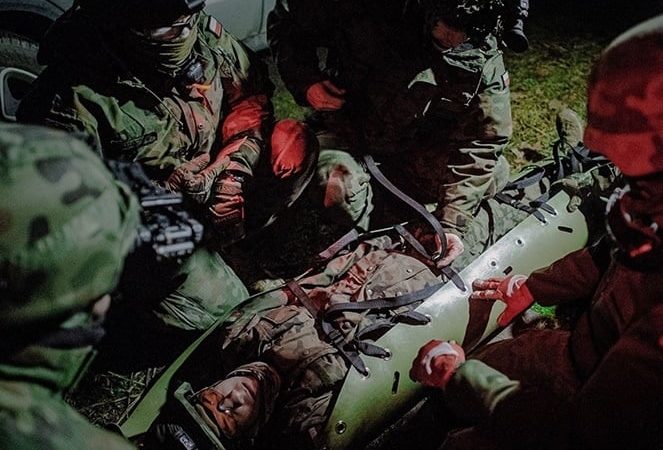
DURATION: 40 hours ( 5-day training)
COURSE PRICE: 1199 zł
At the end of the training course the participant receives:
1) A certificate confirming a positive evaluation in the field of Combat Lifesaver(if the participant passes the final examination)
2) A certificate confirming participation in the course (unless the participant fails the final examination)
3) A souvenir T-shirt
4) Training material in the form of a guidebook for a combat lifesaver based on the latest TC3 regulations
The course is addressed to uniformed services, soldiers, paramedics and people connected with pro-defence organizations and the military or rescue tactics lovers.
It is a full 5-day Combat Lifesaver course based on the latest regulations of TC3 commission (TCCC – Tactical Combat Casuality Care).
The CLS training is performed by experienced paramedics and combats lifesavers from our team who have a considerable experience gained in military operations while doing their service during missions in the Polish Military Contingent or during rescue operations in the State Medical Emergency System.
Due to their active duty for various uniformed services our instructors regularly run courses of similar kinds in their units. Additionally, the members of our team, thanks to their experience gained on foreign missions are able to standarize and upgrade the training programme by comparing the knowledge aquired in real military conditions with the most up-to-date TC3 regulations.
The programme of the course:
Day 1: Theory section, lectures, video tutorials and videos from real military operations
Day 2: Theory section, lectures, video tutorials, introduction to medical and tactical equipment
Day 3: Practice section, team and individual tasks
Day 4: Practice section, team tasks combined with practical scenarios
Day 5: Theoretical and practical exam
- Battlefield rescue and the history of TC3
- The most frequent causes of deaths on a battlefield
- Battlefield rescue – the zones of giving first aid according to TC3
- Acting according to acronyms M.A.R.C.H.E and P.A.W.S
- Massive arterial haemorrhages – physiology, symptoms, procedures
- Stopping massive arterial haemorrhages with the use of improvised dressing
- Stopping massive arterial haemorrhages with the use of tactical stasis
- Stopping massive arterial haemorrhages – hemostatic dressings (wound packing junctional haemorrhage)
- Pneumothorax – physiology, symptoms, types and procedures
- Protection of chest penetrating injuries – improvised dressings
- Protection of chest penetrating injuries – valve and occlusive dressings
- Pneumothorax – needle decompression
- Unblocking the airways: instrumented and toolless
- Trauma patient examination in a safe zone
- Head injuries, hypothermia, hypovolemic shock
- Evacuation from battlefield
- Pharmacology of battlefield (CWMP- Combat Wound Medication Pack)
- Field medical card and documentation
- MIST and the 9- line MEDEVAC procedure
- Immobilization of fractures
- Patient monitoring and reassessment
- SIT report – handing over the patient
- Triage – selection of the wounded
